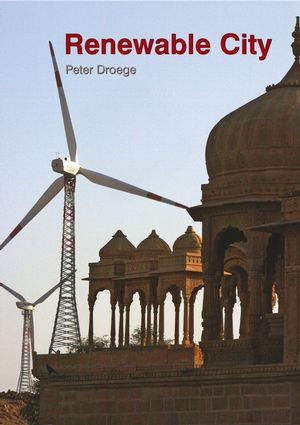The Renewable City: A comprehensive guide to an urban revolutionISBN: 978-0-470-01926-9
Paperback
328 pages
February 2007
 |
||||||
Introduction.
About this book.
Renewable energy.
The fourth industrial revolution.
Cities as settings of hope.
The price of inaction.
Chapter 1 In the hothouse, beyond the peak: the logic of the urban energy revolution.
1.1 Energy and urban sustainability in the 21st century.
Modern cities thrive on petroleum.
Kyoto: neither far enough nor fast enough.
Fossil and nuclear industries: fighting to maintain their grip.
The global urban explosion: the end?
Cities are seeds of change.
Cities at risk.
1.2 Fossil and nuclear energy systems and the industrial construction of reality.
Expiring mindsets.
Expiring oil, natural gas and uranium supplies.
Age of the fossil fuel city.
The rise of the suburb.
Renewable energy and sprawl.
Fossil war, renewable peace?
Fossil and renewable forms of globalisation.
Myths and denials.
1.3 Summary and outlook: for urban evolution there is no alternative to renewable energy.
Three axioms of urban change.
The urban energy transformation: both possible and necessary.
Local change is underway.
The global context: rise of the renewable energy economy.
Chapter 2 How to cope with Peak Oil by preparing for climate change.
2.1 Confronting the risks to cities.
Serial surprises.
Three birds with one stone.
Canary islands.
2.2 Mitigating adaptation.
The long race to the brink.
Beyond the brink: beyond adaptation.
Adapting while mitigating.
Mounting prospects of discontinuous urban change.
2.3 Urban risks.
Gauging and managing urban risks.
Hazards and exposure.
Carbon hazards.
2.4 Urban exposure and impacts.
Gauging exposure.
Anticipating impacts: physical, social and economic.
Characterising impacts.
2.5 Urban vulnerability.
Lowering vulnerability.
Vulnerability: 10 coping strategies.
The means of adaptation: planning for change.
Institutional perspectives.
Chapter 3 Renewable geography.
3.1 Other drivers of change.
Innovation.
A rich source of new employment.
Community ownership of power; control over real and virtual utilities.
Accountability: user sees, user pays, user gains.
Public policy response.
Regional regeneration and revalorisation impulses in the global urban regime.
A new urban reality.
3.2 The design of the Renewable City.
The coming energy web.
Changing the culture.
Beyond efficiency.
3.3 Renewable City form and formation.
From plain old grid to intelligent energy web.
Renewable urbanism.
Islands of autonomy.
3.4 Space, time and energy: storing and dispatching renewable power.
Internal and external supply.
Balance and storage.
Hydrogen city?
3.5 Renewable citizenship: support communities and programmes.
Networks and support programmes.
Long-range needs and short-term horizons.
Climate stabilisation and city programmes: local efforts.
Chapter 4 Building the Renewable City: tools, trades, technology.
4.1 Form follows fuel.
Evolution of efficiency.
Fossil mobility and the urban energy crisis.
Motors, movement and renewable fuels.
Transport planning and policy imperatives.
4.2 Citywide efficiency.
The end of the techno-fix.
Heat island relief: the ancient wisdom of renewable city design.
Trees, parks, urban wilds and agriculture.
Planted walls and roofs.
Water in the renewable city.
Designing buildings with daylight in mind.
Urban heat pumps: city power from the ground, water and air.
Renewable rights and development control.
4.3 The Renewable City toolbox.
Overview of tools.
Citywide renewable energy mapping (C-REM).
City-integrated photovoltaics (CIPV).
Solar roof programmes, and other dos and don’ts in national efforts.
Urban sun collectors: city-integrated solar-thermal technology.
Urban wind power.
Urban waterpower.
Regional renewable power systems (RRPS): from intra- to extra-urban generation.
Bio-energy farms and forests: biomass, biofuel, biogas.
4.4 Urban renewable power finance.
Development and production.
Commercialisation.
Financial benefits of distributed energy: direct renewable power and cogeneration.
4.5 Municipal power.
Chapter 5 Renewable City buildings: guidance and learning.
5.1 Renewable city building tools: rating performance.
Breeam.
Energy Star.
LCAid.
LEED.
NABERS.
BASIX.
Built integration: the emergence of renewable building practice.
5.2 Learning from renewable building practice.
The state of standards, regulations, and rating systems.
The design process.
Time is energy.
Construction considerations.
Materials matter.
Technical, media and general support.
Finance aspects.
A change in culture.
Before and after.
Chapter 6 Renewable City planning and action: guides for local government.
6.1 The Solar City programme.
Programme structure.
1 Rationale and background.
2 Aims and scope.
3 Objectives.
4 Key aspects.
5 Task A: Solar City strategies: renewable-energy based city planning.
6 Subtask B: Targets, baseline studies and scenarios.
7 Task C: urban renewable energy systems, business and industry development.
8 Communications.
9 Milestones: sample schedule.
6.2 The Renewable City™ rating framework.
Glossary.
References and Webography.
Index.



